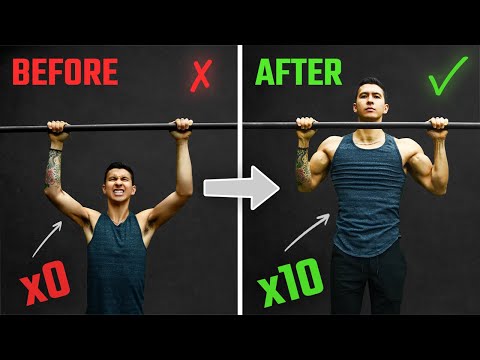
Pullups are generally one of the most difficult exercises to master. In fact, most individuals have yet to even achieve their first pull up. And for those who have, they’ll then often struggle to increase reps on pullups. Although you’ve probably already tried a few things to help increase pullup strength or achieve your first ever pull-up, the truth is that most people simply use the wrong approaches when it comes to how to improve pullups. In this video though, I’ll show you what research indicates are the most effective steps and routines to achieving your first pull-up and then how to increase pullups into the double digits in the fastest way possible.
The first thing you need to do to increase reps on pullups is focus on strengthening the prime movers involved. The first exercise will be the scapular pull-ups, which targets the lower traps. For this, simply hang from a bar, relax your shoulders down and away from your ears, and then pull your body up without allowing your elbows to bend with a slight pause at the top. Next will be the kneeling lat pulldown, which primarily strengthens the lats and the core, as well as the biceps. Theoretically, this exercise provides the best strength transference to your pull-up given the similarly of both movements in terms of muscle activation patterns and is therefore essential that we include it here.
Next, we’re going to use the inverted row to further increase pullup strength by strengthening the pulling strength of your lats, core, and arms but to also emphasize the mid-traps a little more. For this, simply hang from a bar with your legs extended on the ground and pull up until your chest just about reaches the bar. Then, you’ll want to progress this overtime by simply lowering the bar and/or elevating your feet to get your body more horizontal.
To really improve pullups, we want to get some actual pull-up training in to neurologically get better at the movement itself. If you’re unable to do a pull-up or just can’t do very many, you’ll have to first use alternative exercises to accomplish this. And the first exercise we’ll use for this purpose is the banded pull-up, which I’d highly recommend incorporating since it’s the closest exercise to the pull-up itself. The second exercise will be the negative pull-ups. These help with strengthening the eccentric portion of the pull-up and to also just get you more comfortable with feeling what it’s like to control your bodyweight against gravity. You’ll want to try to work up to a 30 second descent, which will translate to huge strength gains in your actual pullups.
To sum it all up for you, here’s the overall action plan designed to take you to your first pull-up, then to your first 10-12 pull-ups, and then to your first weighted pull-up and beyond:
Step 1: Getting to 10-12 Pull-Ups Straight
Perform & Progress The Following 2x/week:
Scapular Pull-Ups: 3 sets of 10-15 reps
Banded Pull-Ups: 3 sets of 6-12 reps
Kneeling Lat Pulldowns: 3 sets of 10-15 reps
Inverted Row: 3 sets of 8-12 reps (LOWER ANGLE OVERTIME)
Pull-Up Negatives: 2-3 sets (WORK UP TO 30S DESCENT)
*Add 2 “max pull-up” sets to the beginning of these workouts and also to 1-2 of your other weights workouts during the week
Step 2: Progression
Perform weighted pull-ups 2x/week (on one day, use a pull-up variation) for 3-4 sets of 6-10 reps.
Start with 2.5-5lbs additional weight, then continue adding 2.5-5lbs more once you can successfully complete 3-4 sets of 10 reps with previous weight.
Take a pull-ups “deload” or “easy” week after every 4 weeks.
Hopefully you can see that by applying the right science and the proper steps into your weekly routine, you’ll be able to experience significantly faster results when it comes to how to increase pullups. And for a step-by-step science-based program that builds these protocols and exercises into your weekly plan for you and shows how to properly progress them overtime such that you can break through plateaus and pack on size and strength in the most effective way possible, then take the analysis quiz below to discover which approach is best for your body:
Filmed by: Bruno Martin Del Campo
MUSIC:
Music by Ryan Little – Keep Quiet –
STUDIES:
PRIME MOVERS
SCAPULAR PULLUPS
KNEELING LAT PULLDOWN
https://juniperpublishers.com/jpfmts/pdf/JPFMTS.MS.ID.555669.pdf
INVERTED ROW
BANDED PULLUPS
VARIATIONS
Subscribe to my channel here:
1






